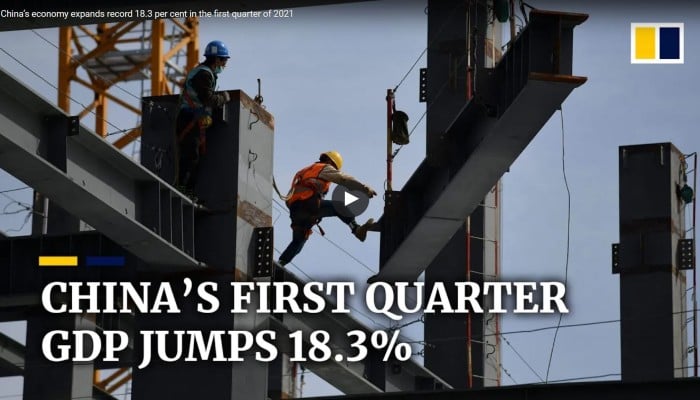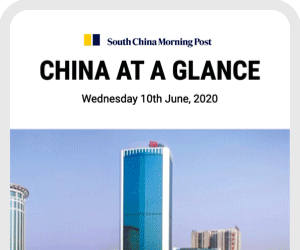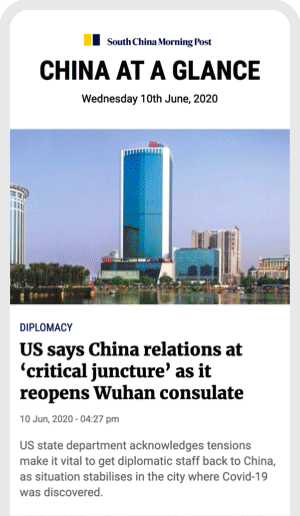Hello again SCMP Global Impact readers,
China was the first economy in the world to succumb to the coronavirus pandemic, but the first to emerge from the other side. China’s economy has led the global economic recovery and continues to be a top growth driver going forward, meaning its outlook is central to that for the entire world.
In this issue, we’ll look at the state of the Chinese economy today and peer into our looking glass to try to divine where it’s headed, in the hope of shedding some light on the subject.
John Carter
Senior Editor, Political EconomyTrying to thread the needle: not too hot, not too cold, just right
Beijing, like other governments around the world, is trying to thread the needle in setting economic policy as it continues to recover from the damage caused by the coronavirus pandemic. Trying to create a Goldilocks economy: not too hot, not too cold, but just right.
This is challenging in any context, but more so given the continued drag on growth - both in China and abroad - caused by the sharp resurgence in the Delta variant of the coronavirus. The economic impact was evident immediately: China’s draconian efforts to contain the Delta outbreak shut down the port of Yantian in southern China, one of the busiest container shipping ports in the world.
Beijing’s policy priorities seem clear: create sufficient growth to absorb new entrants to the labour force - including nine million new graduates this year - while at the same time starting to upwind the world’s largest pile of government, corporate and household debt accumulated since the Global Financial Crisis. A challenging work agenda.
So Beijing wants to keep the economy on an even keel, even amid expectations that growth will slow as the year progresses. Just released data suggest that the economy is holding up quite well.
As expected, Chinese economic growth slowed by 7.9 per cent in the second quarter compared to a year earlier, down from a record 18.3 per cent growth rate in the first quarter. However, compared to the previous quarter - which minimises the impact of base effects on the calculation - growth rebounded strongly to 1.3 per cent from 0.4 per cent in the first quarter. In addition, both industrial production and retail sales were stronger than expected.
In addition, Chinese exports again grew stronger than expected in June, as the China trade juggernaut gathered pace. Export growth had been predicted to slow in June as the economic recovery in industrial countries picked up pace, meaning they could produce their own goods rather than importing them. Predictions of a slowdown in the second half of this year persist, which would drag on growth.
But observers should be cautious of the trade outlook, given that similar predictions of an export slowdown were made for the fourth quarter last year. Instead, exports continued to surge to record levels in October, November and December, creating a record trade surplus and helping to power the Chinese economy forward.
With the economy doing fairly well at the moment, but predictions of a further slowdown prevalent, analysts are debating what economic stimulus steps Beijing might have to roll out in the coming months.
Earlier this year, Beijing promised “no U-turn” on economic support, meaning that it would not consider a return to the aggressive monetary and fiscal policies employed in the spring of 2020 to combat the economic damage caused by the pandemic. The government had stopped providing extra liquidity to financial markets and had cut back on fiscal spending.
But the government statement left room for “fine tuning” of economic support policy if the need arose.
On July 7, the State Council, China’s government cabinet, surprised by indicating for the first time in more than a year that the government was ready to ease monetary policy modestly by cutting banks’ reserve ratios - the amount of money they have to set aside against future loan losses.
Two days later, the People’s Bank of China (PBOC), the nation’s central bank, delivered, announcing a cut that would free up 1 trillion yuan (US$154 billion) for banks to lend. However, the PBOC downplayed the move as a structural adjustment and analysts said it would have little economic impact in the short-run.
That move suggested to analysts that the government was worried about the economic outlook and so predictions of new fiscal stimulus measures were put on the table despite the strong economic data for June.
The question is how much of a slowdown in growth Beijing will tolerate for the rest of the year.
Note that if growth were to slow to a 6 per cent rate in the fourth quarter this year, the Chinese economy would be right back where it was in the fourth quarter of 2019, before the pandemic began, when the economy grew 6.0 per cent compared to a year earlier.
At the end of 2019, analysts expected Beijing to set a growth target of “around 6 per cent” for 2020, in what they judged to be the minimum growth rate that would allow the government to achieve its objectives.
In other words, the pandemic produced a two-year interruption in the “new normal” growth path for the Chinese economy. It also could suggest that Beijing’s most recent policy fine tuning moves were meant to ensure growth would not fall much below 6 per cent at the end of year, rather than signalling broader concern about the economy that would require stronger policy action.
This is not to say that the Chinese economy is out of the woods. Given the rapid spread of the Delta coronavirus variant, more action may be needed in the future to prop up growth. But for now, expectations of substantial additional economic stimulus may be overdone.
- South China Morning Post, SCMP -
Hello again SCMP Global Impact readers,
China was the first economy in the world to succumb to the coronavirus pandemic, but the first to emerge from the other side. China’s economy has led the global economic recovery and continues to be a top growth driver going forward, meaning its outlook is central to that for the entire world.
In this issue, we’ll look at the state of the Chinese economy today and peer into our looking glass to try to divine where it’s headed, in the hope of shedding some light on the subject.
John Carter
Senior Editor, Political EconomyTrying to thread the needle: not too hot, not too cold, just right
Beijing, like other governments around the world, is trying to thread the needle in setting economic policy as it continues to recover from the damage caused by the coronavirus pandemic. Trying to create a Goldilocks economy: not too hot, not too cold, but just right.
This is challenging in any context, but more so given the continued drag on growth - both in China and abroad - caused by the sharp resurgence in the Delta variant of the coronavirus. The economic impact was evident immediately: China’s draconian efforts to contain the Delta outbreak shut down the port of Yantian in southern China, one of the busiest container shipping ports in the world.
Beijing’s policy priorities seem clear: create sufficient growth to absorb new entrants to the labour force - including nine million new graduates this year - while at the same time starting to upwind the world’s largest pile of government, corporate and household debt accumulated since the Global Financial Crisis. A challenging work agenda.
So Beijing wants to keep the economy on an even keel, even amid expectations that growth will slow as the year progresses. Just released data suggest that the economy is holding up quite well.
As expected, Chinese economic growth slowed by 7.9 per cent in the second quarter compared to a year earlier, down from a record 18.3 per cent growth rate in the first quarter. However, compared to the previous quarter - which minimises the impact of base effects on the calculation - growth rebounded strongly to 1.3 per cent from 0.4 per cent in the first quarter. In addition, both industrial production and retail sales were stronger than expected.
In addition, Chinese exports again grew stronger than expected in June, as the China trade juggernaut gathered pace. Export growth had been predicted to slow in June as the economic recovery in industrial countries picked up pace, meaning they could produce their own goods rather than importing them. Predictions of a slowdown in the second half of this year persist, which would drag on growth.
But observers should be cautious of the trade outlook, given that similar predictions of an export slowdown were made for the fourth quarter last year. Instead, exports continued to surge to record levels in October, November and December, creating a record trade surplus and helping to power the Chinese economy forward.
With the economy doing fairly well at the moment, but predictions of a further slowdown prevalent, analysts are debating what economic stimulus steps Beijing might have to roll out in the coming months.
Earlier this year, Beijing promised “no U-turn” on economic support, meaning that it would not consider a return to the aggressive monetary and fiscal policies employed in the spring of 2020 to combat the economic damage caused by the pandemic. The government had stopped providing extra liquidity to financial markets and had cut back on fiscal spending.
But the government statement left room for “fine tuning” of economic support policy if the need arose.
On July 7, the State Council, China’s government cabinet, surprised by indicating for the first time in more than a year that the government was ready to ease monetary policy modestly by cutting banks’ reserve ratios - the amount of money they have to set aside against future loan losses.
Two days later, the People’s Bank of China (PBOC), the nation’s central bank, delivered, announcing a cut that would free up 1 trillion yuan (US$154 billion) for banks to lend. However, the PBOC downplayed the move as a structural adjustment and analysts said it would have little economic impact in the short-run.
That move suggested to analysts that the government was worried about the economic outlook and so predictions of new fiscal stimulus measures were put on the table despite the strong economic data for June.
The question is how much of a slowdown in growth Beijing will tolerate for the rest of the year.
Note that if growth were to slow to a 6 per cent rate in the fourth quarter this year, the Chinese economy would be right back where it was in the fourth quarter of 2019, before the pandemic began, when the economy grew 6.0 per cent compared to a year earlier.
At the end of 2019, analysts expected Beijing to set a growth target of “around 6 per cent” for 2020, in what they judged to be the minimum growth rate that would allow the government to achieve its objectives.
In other words, the pandemic produced a two-year interruption in the “new normal” growth path for the Chinese economy. It also could suggest that Beijing’s most recent policy fine tuning moves were meant to ensure growth would not fall much below 6 per cent at the end of year, rather than signalling broader concern about the economy that would require stronger policy action.
This is not to say that the Chinese economy is out of the woods. Given the rapid spread of the Delta coronavirus variant, more action may be needed in the future to prop up growth. But for now, expectations of substantial additional economic stimulus may be overdone.
|
Was this newsletter forwarded to you? Subscribe here
|

|
|
|
|
|
17 July 2021 |
|
Welcome to the 1,700 newly joined SCMP Global Impact readers who signed up in the past week.
|
|
Hello again SCMP Global Impact readers,
China was the first economy in the world to succumb to the coronavirus pandemic, but the first to emerge from the other side. China’s economy has led the global economic recovery and continues to be a top growth driver going forward, meaning its outlook is central to that for the entire world.
In this issue, we’ll look at the state of the Chinese economy today and peer into our looking glass to try to divine where it’s headed, in the hope of shedding some light on the subject.
John Carter
Senior Editor, Political Economy
Trying to thread the needle: not too hot, not too cold, just right
Beijing, like other governments around the world, is trying to thread the needle in setting economic policy as it continues to recover from the damage caused by the coronavirus pandemic. Trying to create a Goldilocks economy: not too hot, not too cold, but just right.
This is challenging in any context, but more so given the continued drag on growth - both in China and abroad - caused by the sharp resurgence in the Delta variant of the coronavirus. The economic impact was evident immediately: China’s draconian efforts to contain the Delta outbreak shut down the port of Yantian in southern China, one of the busiest container shipping ports in the world.
Beijing’s policy priorities seem clear: create sufficient growth to absorb new entrants to the labour force - including nine million new graduates this year - while at the same time starting to upwind the world’s largest pile of government, corporate and household debt accumulated since the Global Financial Crisis. A challenging work agenda.
So Beijing wants to keep the economy on an even keel, even amid expectations that growth will slow as the year progresses. Just released data suggest that the economy is holding up quite well.
As expected, Chinese economic growth slowed by 7.9 per cent in the second quarter compared to a year earlier, down from a record 18.3 per cent growth rate in the first quarter. However, compared to the previous quarter - which minimises the impact of base effects on the calculation - growth rebounded strongly to 1.3 per cent from 0.4 per cent in the first quarter. In addition, both industrial production and retail sales were stronger than expected.
In addition, Chinese exports again grew stronger than expected in June, as the China trade juggernaut gathered pace. Export growth had been predicted to slow in June as the economic recovery in industrial countries picked up pace, meaning they could produce their own goods rather than importing them. Predictions of a slowdown in the second half of this year persist, which would drag on growth.
But observers should be cautious of the trade outlook, given that similar predictions of an export slowdown were made for the fourth quarter last year. Instead, exports continued to surge to record levels in October, November and December, creating a record trade surplus and helping to power the Chinese economy forward.
With the economy doing fairly well at the moment, but predictions of a further slowdown prevalent, analysts are debating what economic stimulus steps Beijing might have to roll out in the coming months.
Earlier this year, Beijing promised “no U-turn” on economic support, meaning that it would not consider a return to the aggressive monetary and fiscal policies employed in the spring of 2020 to combat the economic damage caused by the pandemic. The government had stopped providing extra liquidity to financial markets and had cut back on fiscal spending.
But the government statement left room for “fine tuning” of economic support policy if the need arose.
On July 7, the State Council, China’s government cabinet, surprised by indicating for the first time in more than a year that the government was ready to ease monetary policy modestly by cutting banks’ reserve ratios - the amount of money they have to set aside against future loan losses.
Two days later, the People’s Bank of China (PBOC), the nation’s central bank, delivered, announcing a cut that would free up 1 trillion yuan (US$154 billion) for banks to lend. However, the PBOC downplayed the move as a structural adjustment and analysts said it would have little economic impact in the short-run.
That move suggested to analysts that the government was worried about the economic outlook and so predictions of new fiscal stimulus measures were put on the table despite the strong economic data for June.
The question is how much of a slowdown in growth Beijing will tolerate for the rest of the year.
Note that if growth were to slow to a 6 per cent rate in the fourth quarter this year, the Chinese economy would be right back where it was in the fourth quarter of 2019, before the pandemic began, when the economy grew 6.0 per cent compared to a year earlier.
At the end of 2019, analysts expected Beijing to set a growth target of “around 6 per cent” for 2020, in what they judged to be the minimum growth rate that would allow the government to achieve its objectives.
In other words, the pandemic produced a two-year interruption in the “new normal” growth path for the Chinese economy. It also could suggest that Beijing’s most recent policy fine tuning moves were meant to ensure growth would not fall much below 6 per cent at the end of year, rather than signalling broader concern about the economy that would require stronger policy action.
This is not to say that the Chinese economy is out of the woods. Given the rapid spread of the Delta coronavirus variant, more action may be needed in the future to prop up growth. But for now, expectations of substantial additional economic stimulus may be overdone.
|
|
|
|
|
|

|
|
Chinese central bank pledges no change over risk management
|
| • |
The People’s Bank of China said it would maintain tight financial supervision and continue to strengthen controls | | | • | The pledge comes despite a shrinking shadow banking sector
|
|
|
China’s central bank has pledged there will be no turnaround in the country’s prudent monetary stance and tight financial supervision. A statement from the People’s Bank of China on Friday indicated that it would continue to target financial risk despite the size of the country’s shadow banking sector being squeezed to an eight-year low in proportion to gross domestic product. Read more
|
|
|
|

|
|
China-Europe rail trade posts record traffic via Xinjiang, despite tensions
|
| • |
Railway network between Europe and China saw a record number of freight train trips through Xinjiang in the first six months of the year | | | • | Rail line has prospered thanks to soaring sea freight costs and despite worsening relations between the European Union and China
|
|
|
The China Railway Express has withstood rising tensions between the European Union and China to post record cargo traffic through Xinjiang in the first half of the year amid sky-high sea freight rates caused by the coronavirus pandemic. The railway network between Europe and China is a key component of President Xi Jinping’s Belt and Road Initiative, which seeks to link Asia, Europe and Africa with a network of ports, motorways and railways. Read more
|
|

|
|
|

|

|
|
China’s economic policy diverging from US while ‘putting own needs first’, central bank says
|
| • |
Head of monetary policy says China’s economic focus is primarily on maintaining stability in its own financial markets | | | • | But diverging policies with the US may result in different interest rates and currency exchange rates that would be likely to cause unintended hot capital flows
|
|
|
China has shrugged off the monetary policy shift by the US Federal Reserve and says maintaining stability in its own domestic financial markets is the main priority at this stage in its post-pandemic economic recovery, which is further along than that of the United States. The position was relayed on Tuesday by the head of the central bank’s monetary policy department, Sun Guofeng. He acknowledged that the People’s Bank of China (PBOC) has taken notice of recent market discussions over a potential tightening by the Fed, but stressed that China’s financial markets are operating smoothly. Read more
|
|

|
|
US-China trade war hits third anniversary, with no sign of Joe Biden easing economic pressure
|
| • |
Three years after the US imposed its first trade war tariffs, they remain in place for most goods under the Biden administration | | | • | While the two countries initially sparred over trade, tensions now touch on things like Xinjiang, Hong Kong and human rights
|
|
|
Three years after the US and China began a tit-for-tat trade war, the tariffs imposed by the Trump administration remain in place on most Chinese goods, and bilateral tensions have extended beyond trade to encompass a range of geopolitical and human rights issues under US President Joe Biden. Since the signing of the phase one deal in January last year, Beijing has repeatedly urged the US to roll back its punitive tariffs on Chinese products and called on the American business community to help convince Washington. But US officials, including Trade Representative Katherine Tai, have said the tariffs will remain in place for now. Read more
|
|
|
To keep track of the latest global news developments, follow our daily coverage on our website, or focus on stories about the Chinese and global economies here.
In our next issue, we’ll look at the recent 100th anniversary of the Chinese Communist Party and what it means for the nation’s future.
We welcome your feedback. Email me at globalimpact@scmp.com or tweet me at @scmpeconomy.
All the best,
John
|

|
|
John Carter
Senior Editor, Political Economy
|
|
|
|
|
|
| SCMP NEWSLETTERS THAT MAY INTEREST YOU |

China at a Glance
A wealth of insights giving you the inside story on China every day.
China Economic Update
The latest developments from trade relations to growth rates and other key economic data.
Inside China Tech
Our weekend newsletter covering the biggest stories and updates from the tech centres of China.
VIEW AND SIGN UP
|

|
|
|
Download our app
To get push notifications direct and never miss a story as it breaks
|
|
|
|
|
Hong Kong
China
Asia
World
Economy
Business
Tech
Comment
|
|
|
|
Copyright © 2021 South China Morning Post Publishers Ltd. All rights reserved.
|
|
This newsletter is created and catered for the global news reader. Each issue will feature a news story originating from China that carries a significant macro impact on the rest of the world.
We hope to share with you a broader perspective on the emerging topics shaping our world and that we feel are revolutionising the way we understand China.
|














